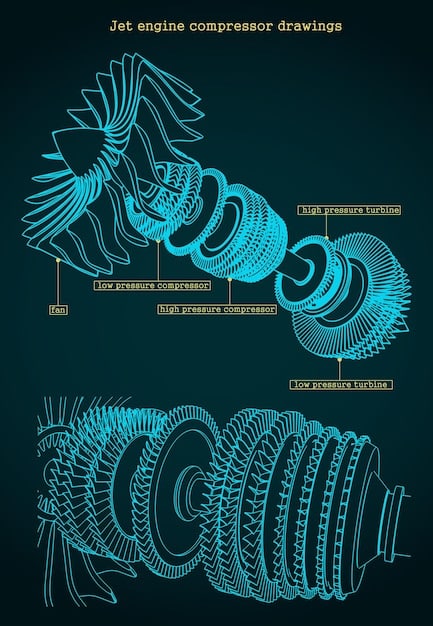New Controller Tech: Haptics & Adaptive Triggers in 2025 Gaming

New controller technology, particularly haptic feedback and adaptive triggers, is poised to significantly transform console gaming by 2025, offering players enhanced immersion and more realistic interactions within virtual worlds.
Will new controller technology revolutionize console gaming by 2025? The integration of haptic feedback and adaptive triggers is set to redefine how we interact with virtual worlds, offering unprecedented levels of immersion and realism.
The Evolution of Controller Technology
Controller technology has come a long way since the simple joysticks of early consoles. Today, advancements like haptic feedback and adaptive triggers are pushing the boundaries of what’s possible, creating a more immersive and engaging gaming experience.
From Rumble to Revolution
The move from basic rumble to sophisticated haptic feedback systems marks a significant leap. Early controllers used simple motors to create vibrations, offering a limited sense of interaction. Haptic feedback, on the other hand, uses advanced actuators to simulate a wide range of tactile sensations, making virtual events feel more real than ever.
Adaptive Triggers: A New Level of Control
Adaptive triggers add another layer of depth by changing the resistance and feel of the trigger based on in-game actions. Imagine feeling the tension of a bowstring as you draw back an arrow, or the subtle feedback of a car’s accelerator as you navigate a challenging turn. This level of control enhances both realism and player engagement.

Here are some key milestones in controller evolution:
- Basic Joysticks: The first generation of controllers offered simple directional input.
- Rumble Technology: Vibration motors added a new dimension of feedback.
- Analog Sticks: Allowed for more precise movement and control.
- Haptic Feedback: Advanced tactile sensations for enhanced immersion.
The evolution of controller technology is driven by a desire to create more realistic and engaging gaming experiences. Haptic feedback and adaptive triggers represent the pinnacle of this evolution, offering unparalleled levels of immersion and control.
Understanding Haptic Feedback
Haptic feedback is more than just vibration; it’s a sophisticated technology that allows players to feel realistic tactile sensations when interacting with virtual environments. This technology relies on advanced actuators and precise programming to deliver a wide range of sensations.
How Does Haptic Feedback Work?
Haptic feedback systems use small motors and actuators to create detailed and nuanced sensations. These actuators can simulate textures, impacts, and even the subtle differences in various surfaces. The result is a more realistic and immersive gaming experience.
The Benefits of Haptic Feedback in Gaming
Haptic feedback offers several key benefits to gamers. It enhances immersion by making virtual interactions feel more real, improves reaction time by providing immediate tactile cues, and adds a new layer of realism to gameplay. Whether you’re feeling the recoil of a weapon or the texture of a surface, haptic feedback brings games to life.
Here are some sensations haptic feedback can simulate:
- Textures: Feel the difference between smooth glass and rough concrete.
- Impacts: Experience the force of collisions and explosions.
- Environmental Effects: Sense the subtle vibrations of rain or wind.
Haptic feedback is a game-changer for console gaming, offering a level of immersion that was previously unattainable. By providing realistic tactile sensations, haptic feedback enhances the overall gaming experience and draws players deeper into virtual worlds.
Exploring Adaptive Triggers
Adaptive triggers are another groundbreaking technology that enhances the gaming experience by adding a new level of control and realism. These triggers can dynamically adjust their resistance and feel based on in-game actions.
How Adaptive Triggers Work
Adaptive triggers use small motors and sensors to adjust the tension and resistance of the trigger. This allows developers to simulate a wide range of mechanical sensations, from the pull of a bowstring to the pressure of a car’s accelerator.
The Impact of Adaptive Triggers on Gameplay
Adaptive triggers significantly impact gameplay by providing tactile feedback that corresponds to in-game actions. This can enhance realism, improve control, and add a new layer of strategy to gaming. For example, feeling the tension of a trigger as you aim a sniper rifle can improve your precision and accuracy.

Examples of adaptive triggers in action:
- Drawing a Bow: Experience the increasing tension as you pull back the string.
- Driving a Car: Feel the resistance of the accelerator as you push down.
- Firing a Weapon: Sense the recoil and feedback of each shot.
Adaptive triggers are a powerful tool for game developers, offering new ways to engage players and create more immersive and realistic gaming experiences. By providing tactile feedback that corresponds to in-game actions, adaptive triggers enhance both realism and control.
Gaming in 2025: What to Expect
Looking ahead to 2025, the integration of haptic feedback and adaptive triggers is expected to become more widespread, with new games and consoles designed to take full advantage of these technologies.
Enhanced Immersion and Realism
By 2025, haptic feedback and adaptive triggers will be standard features in many high-end controllers, offering gamers a level of immersion and realism that was previously unattainable. New games will be designed to take full advantage of these technologies, creating more engaging and lifelike experiences.
New Gameplay Mechanics
The integration of haptic feedback and adaptive triggers will also lead to new gameplay mechanics and strategies. Developers will be able to create more complex and nuanced interactions, allowing players to feel more connected to the virtual world.
Potential advancements in controller technology by 2025:
- More Precise Haptic Feedback: Simulating even more realistic textures and sensations.
- Advanced Adaptive Triggers: Offering greater control and customization.
- Wireless Technology: Improved connectivity and battery life.
Gaming in 2025 promises to be more immersive, realistic, and engaging than ever before, thanks to the continued advancements in controller technology. Haptic feedback and adaptive triggers are at the forefront of this revolution, offering players new ways to interact with and experience virtual worlds.
Potential Challenges and Considerations
While haptic feedback and adaptive triggers offer many benefits, there are also potential challenges and considerations that must be addressed to ensure their widespread adoption and success.
Cost and Accessibility
One potential challenge is the cost of these technologies, as advanced controllers with haptic feedback and adaptive triggers may be more expensive than traditional controllers. This could limit their accessibility to some gamers.
Developer Adoption
Another challenge is ensuring that developers are willing to invest the time and resources needed to properly integrate haptic feedback and adaptive triggers into their games. Without widespread developer adoption, these technologies may not reach their full potential. New controller technology requires testing.
Key considerations for the future of controller technology:
- Standardization: Creating common standards for haptic feedback and adaptive triggers.
- Accessibility: Ensuring that these technologies are affordable and accessible to all gamers.
- Innovation: Continuing to push the boundaries of what’s possible with controller technology.
Despite these challenges, the future of controller technology looks bright. By addressing these challenges and continuing to innovate, haptic feedback and adaptive triggers have the potential to revolutionize console gaming and create more immersive and engaging experiences for players around the world.
The Future of Console Gaming
The integration of haptic feedback and adaptive triggers is just the beginning of a new era in console gaming. As technology continues to evolve, we can expect even more innovative and immersive gaming experiences in the years to come.
Beyond Haptics and Triggers
Looking beyond haptic feedback and adaptive triggers, there are several other technologies that could potentially transform console gaming. These include virtual reality (VR), augmented reality (AR), and cloud gaming.
The Rise of Immersive Gaming Experiences
The future of console gaming is all about creating more immersive and engaging experiences for players. By combining advanced controller technology with cutting-edge graphics and innovative gameplay mechanics, developers will be able to transport players to entirely new worlds.
Possible future technologies:
- Brain-Computer Interfaces: Controlling games with your thoughts.
- Full-Body Haptic Suits: Experiencing tactile sensations throughout your body.
- AI-Powered Game Design: Creating dynamic and personalized gaming experiences.
The future of console gaming is full of exciting possibilities, and the integration of new controller technology like haptic feedback and adaptive triggers is just the first step. As technology continues to evolve, we can expect even more innovative and immersive gaming experiences in the years to come.
| Key Point | Brief Description |
|---|---|
| 🎮 Haptic Feedback | Provides realistic tactile sensations for enhanced immersion. |
| 🕹️ Adaptive Triggers | Dynamically adjust resistance for more realistic gameplay actions. |
| 🚀 Future of Gaming | Expect more immersive and realistic experiences by 2025. |
FAQ
▼
Haptic feedback is advanced tactile technology that simulates realistic sensations, allowing gamers to feel textures, impacts, and environmental effects. It enhances immersion and adds realism to gameplay.
▼
Adaptive triggers use motors and sensors to adjust the resistance and feel of the trigger based on in-game actions. This allows developers to simulate mechanical sensations, enhancing control and realism.
▼
The benefits include enhanced immersion, improved reaction time, and a new layer of realism. Players feel more connected to the virtual world, enhancing the overall gaming experience.
▼
It is expected that haptic feedback and adaptive triggers will become standard features in many high-end controllers by 2025, with new games designed to take full advantage of them.
▼
Potential challenges include the cost of the technology, ensuring developer adoption, and creating common standards for implementation to make it accessible for all gamers.
Conclusion
The integration of haptic feedback and adaptive triggers represents a significant leap forward in console gaming technology, promising to revolutionize the way we interact with virtual worlds. While challenges remain in terms of cost and developer adoption, the potential for enhanced immersion, realism, and innovative gameplay mechanics makes these technologies a game-changer for the future of console gaming.





